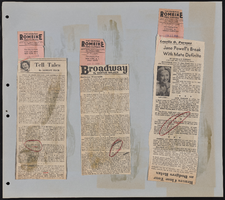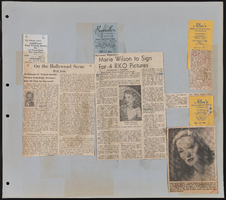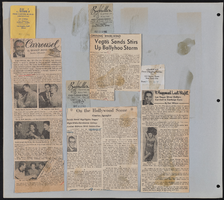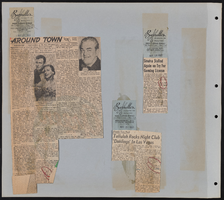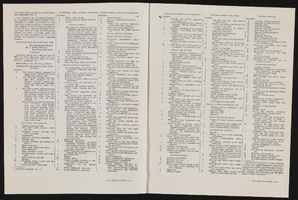Search the Special Collections and Archives Portal
Search Results

Transcript of interview with Laralee Nelson by Claytee White, April 20, 2010
Date
Archival Collection
Description
Laralee Nelson and her four sisters were born and raised in Provo, Utah. She was raised in a Mormon household, her parents worked at Brigham Young University and she attended BYU She was .nearly thirty years old when she moved to Las Vegas with her husband. The move was the first real move away from her Utah home base. She fondly recalls summers at an archaeological dig in Israel while studying for her undergraduate degree. But these were nothing compared to relocating to Las Vegas. Laralee's mother was a librarian at BYU and an obvious inspiration to her career choice. Once she arrived in Las Vegas, she applied for a cataloging position at UNLV. From 1982 to 2010, it was her first and only position. From that span of years, she witnessed monumental changes in the library. Changes in leadership, a move from the old Dickinson Library to the new Lied Library, and the impact of technology. Laralee's anecdotes, especially one about the professor with the red wagon and another about her father clearing a rocky path on a family trip, reveal core success of a library built to serve the university community.
Text

Photograph of Fremont Country Club sign, Las Vegas (Nev.), June 28, 2017
Date
Archival Collection
Description
Site address: 601 Fremont St
Sign owner: City of Las Vegas: Economic and Urban Development owns the building
Sign details: The original construction year of this building was 1957. This bar opened September 2012 as an acclaimed kitschy-chic bar and concert venue. Inside they have Tex-Mex decorations with a merry-go- round horse, an 8 foot steel horseshoe, a covered wagon entryway and antler chandeliers.
Sign condition: 5 - newer sign
Sign form: Blade and Reader Board
Sign-specific description: Surrounding their building there is a reader board that is lined with incandescent light bulbs that sparkle at night time, for this reader board is connected to the adjoining Triple B Bars reader board a well. Above their entrance there is a black blade, on the top part of the blade Fremont is written in an elegant white calligraphy font spelt out horizontally which does illuminate white at night time. Vertically down the blade spells out Country Club in block font letters which illuminates red at night. Along this portion of the blade it is lined with little red LED lights that look like incandescent bulbs that sparkle. On the portion of the blade that faces the road, underneath the word Fremont there is a swirly design that decorates the corner of where the horizontal letters meet the vertical letters, but the design does pop up again a little lower on the sign as well. Though at the bottom of the sign underneath the Country Club letters they have their main F.C.C. logo on a plastic backing that seems to be dimly backlit at night time. Their F.C.C logo consists of a silver shield that looks to be dotted on the perimeter with painted diamonds, the middle portion is checkered red and black in 4 sections then has a crest on it of a longhorn with two golf clubs under its head to act as an iteration of crossbones. Under the longhorn there are calligraphy letters F.C.C. in white.
Sign - type of display: Neon, LED, Incandescents and reader board
Sign - media: Steel and Plastic
Sign - non-neon treatments: Reader Board, plastic backlit sign and light bulbs
Sign animation: Flasher for LED
Sign environment: Located in the East Fremont District, this property is right across the street from the El Cortez and is adjoined to the Triple B Bar. To the East of the property is The Market.
Sign - date of installation: c. 2012
Sign - thematic influences: Since are named as a country club, the crest portion of their sign does have golf clubs as well as is a crest could be on a clothing item that a golfer would wear.
Sign - artistic significance: The blade portion is remnant of the 1950s/60s blade. As well as their logo that is a crest shows an older medieval
Survey - research locations: Assessor's website, Fremont Country Club website
Survey - research notes: Reader board for this property is shared with the Triple Bs reader board and both locations opened in 2012 and signs both installed that year as well.
Survey - other remarks: The adjoining property, Triple B states that they named their bar Backstage Bar and Billiards because it was literally backstage to the Fremont Country Club bar and stage.
Surveyor: Emily Fellmer
Survey - date completed: 2017-08-26
Sign keywords: Blade; Neon; Incandescent; Steel; Plastic; Backlit; Flashing
Mixed Content
Maria Burston Wheeler Papers
Identifier
Abstract
The Maria Burston Wheeler Papers date from approximately the 1850s to 1933 and record Maria Walker's childhood and voyage from Liverpool, England to Salt Lake City, Utah in the United States through her manuscript "My History." The manuscript details her and her family's trans-Atlantic journey as well as her own journey as a married woman, Maria Burston Wheeler, to Las Vegas, Nevada to establish the Mormon Fort located there. Her manuscript details daily life at the fort.
Archival Collection
Ann Valder Papers
Identifier
Abstract
Ann Valder Papers (1963-1984) include agendas and minutes, programs, invitations, events, and newspaper clippings. The papers are limited to the time Valder spent working for the Review Journal and the Valley Times in Las Vegas, Nevada. The activities covered are her work with Southern Nevada Memorial Hospital and the American Cancer Society.
Archival Collection

